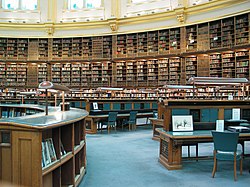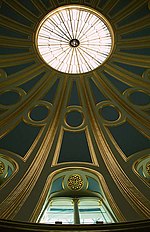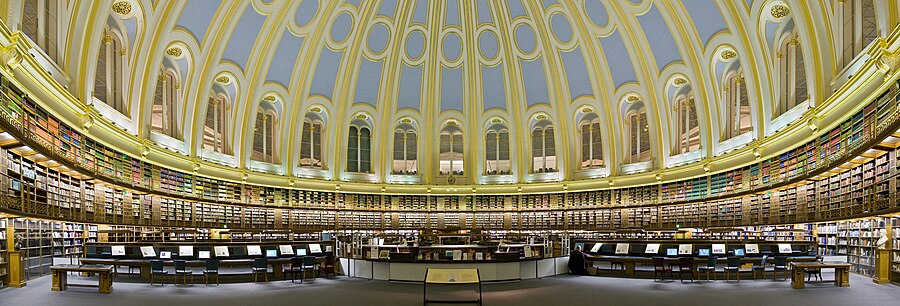
The British Museum is a public museum dedicated to human history, art and culture located in the Bloomsbury area of London. Its permanent collection of eight million works is the largest in the world. It documents the story of human culture from its beginnings to the present. The British Museum was the first public national museum to cover all fields of knowledge.

The Great Exhibition of the Works of Industry of All Nations, also known as the Great Exhibition or the Crystal Palace Exhibition, was an international exhibition that took place in Hyde Park, London, from 1 May to 15 October 1851. It was the first in a series of World's Fairs, exhibitions of culture and industry that became popular in the 19th century. The event was organised by Henry Cole and Prince Albert, husband of Victoria, Queen of the United Kingdom.

The Science Museum is a major museum on Exhibition Road in South Kensington, London. It was founded in 1857 and is one of the city's major tourist attractions, attracting 3.3 million visitors annually in 2019.

State Library Victoria (SLV) is the state library of Victoria, Australia. Located in Melbourne, it was established in 1854 as the Melbourne Public Library, making it Australia's oldest public library and one of the first free libraries in the world. It is also Australia's busiest public library and, as of 2023, the third busiest library globally.

The Royal Air Force Museum London is located on the former Hendon Aerodrome, in North London's Borough of Barnet. It includes five buildings and hangars showing the history of aviation and the Royal Air Force. It is part of the Royal Air Force Museum.

The Crime Museum is a collection of criminal memorabilia kept at New Scotland Yard, headquarters of the Metropolitan Police Service in London, England. Known as the Black Museum until the early 21st century, the museum came into existence at Scotland Yard sometime in 1874, arising out of the collection of prisoners' property gathered as a result of the Forfeiture Act 1870 and intended as an aid to the police in their study of crime and criminals. Initially unofficial, it had become an official if private museum by 1875, with a police inspector and a police constable assigned to official duty there. Not open to the public, it was used as a teaching collection for police recruits and was only ever accessible by those involved in legal matters, royals and other VIPs.
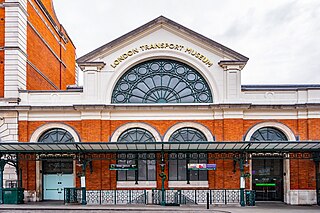
The London Transport Museum (LTM) is a transport museum based in Covent Garden, London. The museum predominantly hosts exhibits relating to the heritage of London's transport, as well as conserving and explaining the history of it. The majority of the museum's exhibits originated in the collections of London Transport, but, since the creation of Transport for London (TfL) in 2000, the remit of the museum has expanded to cover all aspects of transport in the city and in some instances beyond.
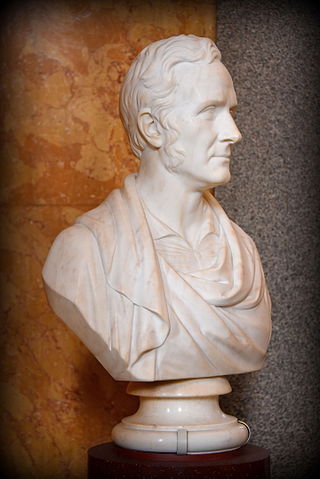
Sir Robert Smirke was an English architect, one of the leaders of Greek Revival architecture, though he also used other architectural styles. As architect to the Board of Works, he designed several major public buildings, including the main block and façade of the British Museum. He was a pioneer of the use of concrete foundations.

The Hypogeum of Ħal Saflieni is a Neolithic subterranean structure dating to the Saflieni phase in Maltese prehistory, located in Paola, Malta. It is often simply referred to as the Hypogeum, literally meaning "underground" in Greek. The Hypogeum is thought to have been a sanctuary and necropolis, with the estimated remains of more than 7,000 people documented by archeologists, and is among the best preserved examples of the Maltese temple building culture that also produced the Megalithic Temples and Xagħra Stone Circle.
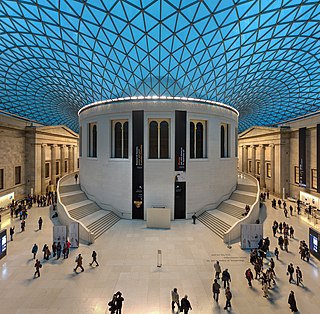
The Queen Elizabeth II Great Court, commonly referred to simply as the Great Court, is the covered central quadrangle of the British Museum in London. It was redeveloped during the late 1990s to a design by Foster and Partners, from a 1970s design by Colin St John Wilson. The court was opened by Queen Elizabeth II in 2000.

Dynamic Earth is a not-for-profit visitor attraction and science centre in Edinburgh, and is Scotland's largest interactive visitor attraction. It is located in Holyrood, beside the Scottish Parliament building and at the foot of Salisbury Crags. It is a registered charity under Scottish law and is owned as The Dynamic Earth Charitable Trust. The centre was opened by Queen Elizabeth II in 1999.

The O2 is a large entertainment district on the Greenwich peninsula in South East London, England, including an indoor arena, a music club, a Cineworld cinema, an exhibition space, piazzas, bars, restaurants, and a guided tour to the top of the O2. It was built largely within the former Millennium Dome, a large dome-shaped canopy built to house an exhibition celebrating the turn of the third millennium; consequently The Dome remains a name in common usage for the venue. It is sometimes referred to as The O2 Arena, but that name properly refers to the indoor arena within The O2. Naming rights to the district were purchased by the mobile telephone provider O2 from its developers, Anschutz Entertainment Group (AEG), during the development of the district. AEG owns the long-term lease on the O2 Arena and surrounding leisure space.

The Stephen A. Schwarzman Building, commonly known as the Main Branch, 42nd Street Library or the New York Public Library, is the flagship building in the New York Public Library system in the Midtown Manhattan neighborhood of New York City. The branch, one of four research libraries in the library system, contains nine separate divisions. The structure contains four stories open to the public. The main entrance steps are at Fifth Avenue at its intersection with East 41st Street. As of 2015, the branch contains an estimated 2.5 million volumes in its stacks. The building was declared a National Historic Landmark, a National Register of Historic Places site, and a New York City designated landmark in the 1960s.

The Harris Museum is a Grade I-listed building in Preston, Lancashire, England. Founded by Edmund Harris in 1877, it is a local history and fine art museum.

Tate Britain, known from 1897 to 1932 as the National Gallery of British Art and from 1932 to 2000 as the Tate Gallery, is an art museum on Millbank in the City of Westminster in London, England. It is part of the Tate network of galleries in England, with Tate Modern, Tate Liverpool and Tate St Ives. It is the oldest gallery in the network, having opened in 1897. It houses a substantial collection of the art of the United Kingdom since Tudor times, and in particular has large holdings of the works of J. M. W. Turner, who bequeathed all his own collection to the nation. It is one of the largest museums in the country. The museum had 525,144 visitors in 2021, an increase of 34 percent from 2020 but still well below pre- COVID-19 pandemic levels. In 2021 it ranked 50th on the list of most-visited art museums in the world.

The King's Library was one of the most important collections of books and pamphlets of the Age of Enlightenment. Assembled by George III, this scholarly library of over 65,000 volumes was subsequently given to the British nation by George IV. It was housed in a specially built gallery in the British Museum from 1827 to 1997 and now forms part of the British Library. The term "King's Library" was until recently also used to refer to the gallery in the British Museum built for the collection, which is now called the "Enlightenment Gallery" and displays a wide range of objects relating to the Enlightenment.

The Tapling Collection of postage stamps was donated to the British Museum from the estate of Thomas Tapling in 1891.
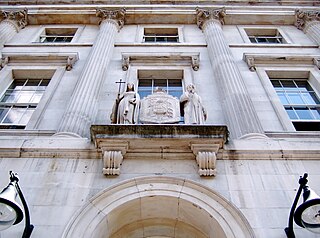
The King's Building is a Grade I listed building that forms part of the Strand Campus of King's College London in the United Kingdom. Originally named the College Building, the King's Building was designed by Sir Robert Smirke in the course of the College's foundation in 1829. As the founding building, it was built between 1829 and 1831 on land granted to King's College by the Government to complete the riverside frontage of Somerset House.

The Professor Aristóteles Orsini Planetarium, also known as the Ibirapuera Planetarium, is a planetarium in Ibirapuera Park, São Paulo. It opened in January 1957, and was the first planetarium in Brazil and Latin America. It is one of three planetaria in São Paulo, with the others being Carmo Planetarium and the Johannes Kepler Planetarium at Sabina Escola Parque do Conhecimento.

Wrexham County Borough Museum is a local history museum in Wrexham, Wrexham County Borough, Wales. It is located within County Buildings, alongside the Wrexham Archives and a proposed Football Museum for Wales. The building is located on Regent Street, in the city centre. The museum is managed by the Wrexham Heritage & Archives Service, which in turn, is operated by Wrexham County Borough Council as part of its Housing & Economy Department.
